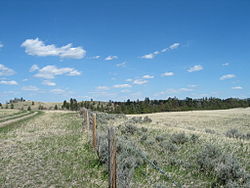Geography of North Dakota


TheGeography of North Dakotaconsists of three major geographic regions: in the east is the Red River Valley, west of this, the Missouri Plateau. The southwestern part ofNorth Dakotais covered by the Great Plains, accentuated by the Badlands. There is also much in the way ofgeologyandhydrology.
North Dakota is about 340 miles (545 km) east to west and 211 miles (340 km) north to south, with a total area of 70,704 square miles (183,123 km²), making it the 19th largest of the 50U.S. states.About 2.4% of North Dakota's area is covered by water.
Geographic divisions
[edit]The Red River Valley
[edit]The Red River Valley takes up the eastern portion of the state, with theRed River of the Northforming the border withMinnesota.
The Valley is the remnant lake bed of the ancientLake Agassiz.It is very flat, and is quite fertile. This area of North Dakota is mostly farm country, withwheat,sugarbeets,andmaizeas staple crops, and along with other crops and livestock, cover the area. The valley contains the lowest point in North Dakota which is the Red River atPembina,at 750 feet (230 m) abovesea level.
The Missouri Plateau and Drift Prairie
[edit]To the west of the Red River Valley is the Drift Prairie and the Missouri Plateau (or Missouri Coteau). The Drift Prairie is bordered on the north by theTurtle Mountainsand separated from the Red River Valley by the Pembina Hills. This area rises from 200 to 2,000 feet over the Red River Valley. The Drift Prairie is covered in lakes, stream valleys, and rolling hills. This region suffers moderate to severe flooding from the Red River almost annually, caused by the heavy snowfall in this region every winter.
The Great Plains
[edit]About half of North Dakota is covered by the Great Plains. The Great Plains, in the southwestern section of the state, are hilly and rich in mineral deposits. This area rises about 300 to 400 feet above the Drift Prairie east of the Missouri River. Along the Missouri River, the land is lower. This area is called the Missouri Break. To the south and west of the river is an area of rugged valleys and buttes called the Slope.
The Badlands
[edit]The Badlands lie in southwestern North Dakota. The Badlands are exposed surfaces of stone and clay thaterosionhas shaped into striking formations; many shades of browns, reds, grays, and yellows appear inbuttes,pyramids, domes, and cones. They stretch for about 190 miles (305 km) and are from 6 to 20 miles (10 to 30 km) wide. In some areas of the Badlands the rocks containlignitecoal that has been burning for many years. The clay above these coal beds has turned bright pink and red. White Butte, the highest point in North Dakota, is located in the Badlands, and stands 3506 feet (1069 m) above sea level.
Climate
[edit]

Notable points
[edit]Extreme points[3]
- Northernmost point: Border withSaskatchewanandManitoba49° N
- Southernmost point: Border withSouth Dakotaat Bois de Sioux River, 45°56'07 "N[4]
- Easternmost point:Bois de Sioux RivernearFairmount,46.084058° N, 96.554405° W[5]
- Westernmost point: Border withMontanaand Saskatchewan, 104° 02' 46 "
Physiographic points
- Highest point:White Butte3507' (1069 m)
- Lowest point:Red River of the Northat Pembina 750' (230 m)
- Mostprominentpoint: Boundary Butte,Turtle Mountains,elevation 2541' (774 m), prominence 1030' (314 m), isolation 95.7 mi. (154 km)[6]
Hydrographic points
- The confluence of theYellowstoneandMissouri RiversnearBuford, North Dakota.
References
[edit]- ^Van Ballenberghe, Victor (2004).In the company of moose.Stackpole Books. p. 1.ISBN0-8117-0102-6.Retrieved2009-09-04.
- ^Galadriel Findlay Watson (2001).North Dakota.Weigl Publishers Inc. p. 8.ISBN1-930954-53-0.Retrieved2009-09-04.
- ^"NORTH DAKOTA'S BOUNDARIES".www.dmr.nd.gov.Retrieved2021-05-15.
- ^Due to a surveying error the southwest point of North Dakota is farther north at about 45°56'43 "N.
- ^"Google Maps".Google Maps.Retrieved2021-05-15.
- ^"Boundary Butte - Peakbagger.com".www.peakbagger.com.Retrieved2021-05-15.

